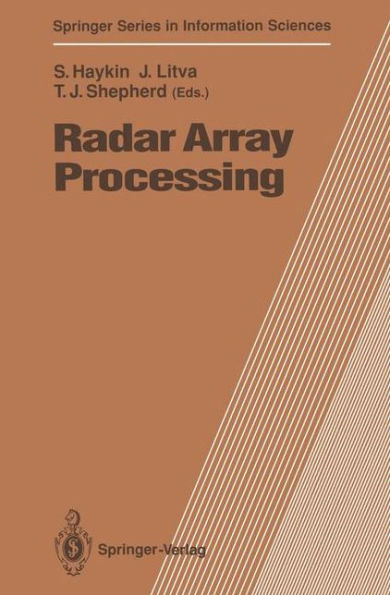5
1

Radar Array Processing
317
Radar Array Processing
317Paperback(Softcover reprint of the original 1st ed. 1993)
$109.99
-
PICK UP IN STORECheck Availability at Nearby Stores
Available within 2 business hours
Related collections and offers
109.99
In Stock
Overview
Radar Array Processing presents modern techniques and methods for processingradar signals received by an array of antenna elements. With the recent rapid growth of the technology of hardware for digital signal processing, itis now possible to apply this to radar signals and thus to enlist the full power of sophisticated computational algorithms. Topics covered in detail here include: super-resolution methods of array signal processing as applied to radar, adaptive beam forming for radar, and radar imaging. This book will be of interest to researchers and studentsin the radar community and also in related fields such as sonar, seismology, acoustics and radio astronomy.

Product Details
| ISBN-13: | 9783642773495 |
|---|---|
| Publisher: | Springer Berlin Heidelberg |
| Publication date: | 12/21/2011 |
| Series: | Springer Series in Information Sciences , #25 |
| Edition description: | Softcover reprint of the original 1st ed. 1993 |
| Pages: | 317 |
| Product dimensions: | 6.10(w) x 9.25(h) x 0.03(d) |
Table of Contents
1. Overview.- I Detection and Estimation.- 2. Radar Detection Using Array Processing.- 2.1 Observation Model.- 2.2 Coherent Radar Detection.- 2.2.1 Signal and Noise Model.- 2.2.2 Detection of Targets with Known Directions.- 2.2.3 Detection of Targets with Unknown Directions.- 2.3 Noncoherent Radar Detection.- 2.3.1 Signal and Noise Model.- 2.3.2 Detection of Targets with Known Directions.- 2.3.3 Detection of Targets with Unknown Directions: Deterministic Signal.- 2.3.4 Detection of Targets with Unknown Directions: Gaussian Signal.- 2.4 Passive Radar Detection.- 2.4.1 Signal and Noise Model.- 2.4.2 Detection of Emitters with Known Directions.- 2.4.3 Detection of Emitters with Unknown Directions: Deterministic Signal.- 2.4.4 Detection of Emitters with Unknown Directions: Gaussian Signal.- 2.5 Discussion.- References.- Additional References.- 3. Radar Target Parameter Estimation with Array Antennas.- 3.1 Radar Parameter Estimation Problem.- 3.1.1 Range and Angle Estimation.- 3.1.2 Frequency and Power Estimation.- 3.2 Angle Estimation.- 3.2.1 Monopulse Estimation (Single Target Estimation).- 3.2.2 Covariance Matrix Estimation.- 3.2.3 Linear Prediction Methods.- 3.2.4 Capon-Pisarenko-Type Methods.- 3.2.5 Signal Subspace Methods.- 3.2.6 Parametric Target Model Fitting.- 3.2.7 Aspects of Implementation.- 3.3 Frequency Estimation.- 3.3.1 Doppler Filter Bank.- 3.3.2 Superresolution Methods.- 3.4 Range, Amplitude and Power Estimation.- 3.4.1 Conventional Range Estimation.- 3.4.2 Superresolution in Range.- 3.4.3 Amplitude and Power Estimation.- 3.5 Summary.- References.- 4. Exact and Large Sample Maximum Likelihood Techniques for Parameter Estimation and Detection in Array Processing.- 4.1 Background.- 4.2 Chapter Outline.- 4.3 Sensor Array Processing.- 4.3.1 Narrowband Data Model.- 4.3.2 Parametric Data Model.- 4.3.3 Assumptions and Problem Formulation.- 4.3.4 Parameter Identifiability.- 4.4 Exact Maximum Likelihood Estimation.- 4.4.1 Shastic Maximum Likelihood Method.- 4.4.2 Deterministic Maximum Likelihood Method.- 4.4.3 Bounds of Estimation Accuracy.- 4.4.4 Asymptotic Properties of Maximum Likelihood Estimates.- 4.4.5 Order Relations.- 4.5 Large Sample Maximum Likelihood Approximations.- 4.5.1 Subspace Based Approach.- 4.5.2 Relation Between Subspace Formulations.- 4.5.3 Relation to Maximum Likelihood Estimation.- 4.6 Calculating the Estimates.- 4.6.1 Newton-Type Search Algorithms.- 4.6.2 Gradients and Approximate Hessians.- 4.6.3 Uniform Linear Arrays.- 4.6.4 Practical Aspects.- 4.7 Detection of Coherent/Noncoherent Signals.- 4.7.1 Generalized Likelihood Ratio Test Based Detection.- 4.7.2 Subspace Based Detection.- 4.8 Numerical Examples and Simulations.- 4.9 Conclusions.- Appendix 4.A Differentiation of the Projection Matrix.- Appendix 4.B Asymptotic Distribution of the Weighted Subspace Fitting Criterion.- References.- II Systolic Arrays.- 5. Systolic Adaptive Beamforming.- 5.1 Adaptive Antenna Arrays.- 5.2 Systolic and Wavefront Arrays.- 5.3 Canonical Problem.- 5.3.1 Canonical Configuration.- 5.3.2 Least-Squares Formulation.- 5.4 QR Decomposition by Givens Rotations.- 5.4.1 QR Decomposition.- 5.4.2 Givens Rotations.- 5.4.3 Systolic Array Implementation.- 5.4.4 Square-Root-Free Algorithm.- 5.4.5 Sensitivity to Arithmetic Precision.- 5.5 Direct Residual Extraction.- 5.5.1 Definition of Residuals.- 5.5.2 Properties of Rotation Matrix Q?(n).- 5.5.3 A Posteriori Residual Extraction.- 5.5.4 A Priori Residual Extraction.- 5.6 Weight Freezing and Flushing.- 5.6.1 Basic Concept.- 5.6.2 Frozen Networks.- 5.6.3 Serial Weight Flushing.- 5.6.4 Further Insights.- 5.7 Linear Constraint Pre-Processor.- 5.7.1 Single Constraint Pre-Processor.- 5.7.2 Multiple Constraint Pre-Processor.- 5.7.3 Generalized Sidelobe Canceller.- 5.8 Minimum Variance Distortionless Response Beamforming.- 5.8.1 Schreiber’s Algorithm.- 5.8.2 SystoUc Array Implementation.- 5.8.3 Square-Root-Free Minimum Variance Distortionless Response Algorithm.- 5.9 Adaptive Antenna Processor Test-Bed.- 5.9.1 Wavefront Array Processor.- 5.10 Further Developments.- 5.10.1 Parallel Weight Extraction.- 5.10.2 QR-with-Feedback.- 5.10.3 Structures for Broad-Band Adaptive Beamforming.- 5.10.4 QR Decomposition and Neural Networks.- 5.11 Comments and Conclusions.- 5.11.1 Additional Topics.- Appendix 5.A Modified Gram-Schmidt Algorithm.- Appendix 5.B Constraints with Leading Zeros.- Appendix 5.C Weighted Least-Squares and Hyperbolic Rotations.- Appendix 5.D Principal Symbols Used in this Chapter.- References.- 6. Two-Dimensional Adaptive Beamforming: Algorithms and Their Implementation.- 6.1 Arrangement of the Chapter.- 6.2 Adaptive Beamforming Techniques.- 6.2.1 Introduction.- 6.2.2 Classical Adaptive Beamforming.- 6.2.3 Modern Adaptive Beamforming.- 6.3 2D Adaptive Beamforming Algorithm and Implementation.- 6.3.1 Introduction.- 6.3.2 Classical Approaches.- 6.3.3 2D QRD-LS Algorithm and Systolic Array Implementation.- 6.4 Simulation Results.- 6.5 Concluding Remarks.- References.- III Imaging.- 7. The Radio Camera.- 7.1 Problems.- 7.2 Adaptive Beamforming: Dominant Scatterer Algorithm.- 7.3 Experiments.- 7.4 Adaptive Beamforming: Spatial Correlation Algorithm.- 7.5 Experiments.- 7.6 Number of Elements.- 7.7 Number of Bits per Sample.- 7.8 Data Truncation.- 7.9 Conclusions.- References.From the B&N Reads Blog
Page 1 of
